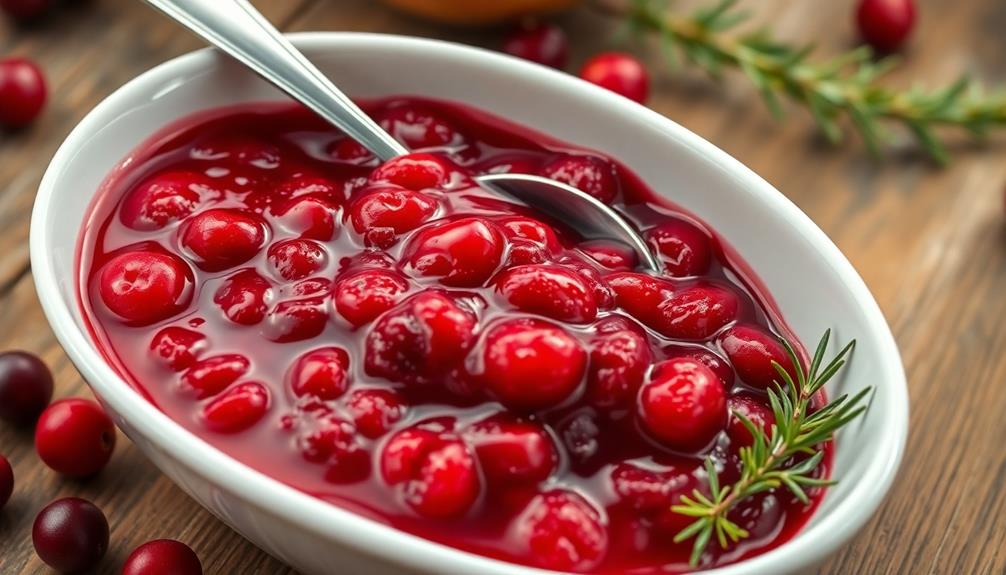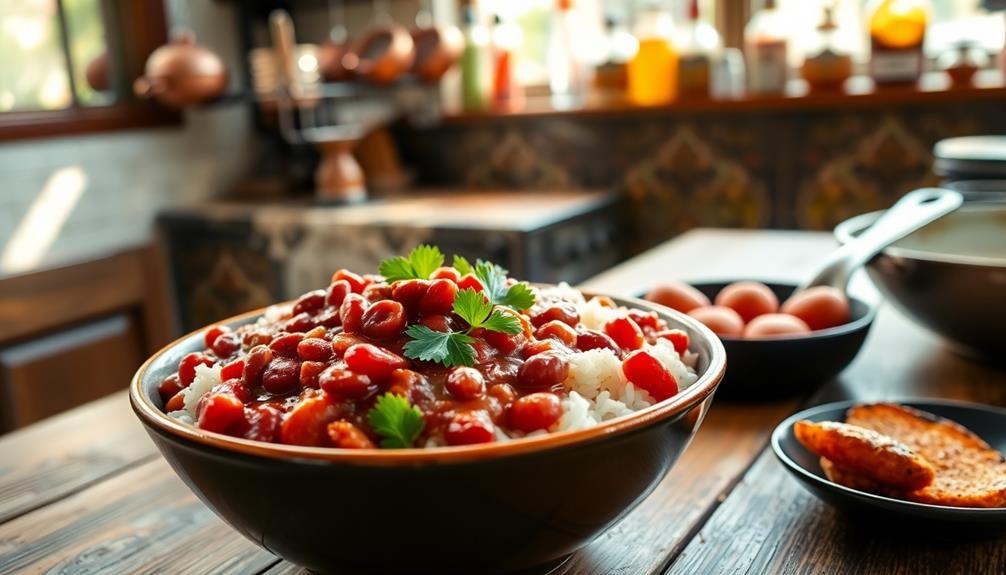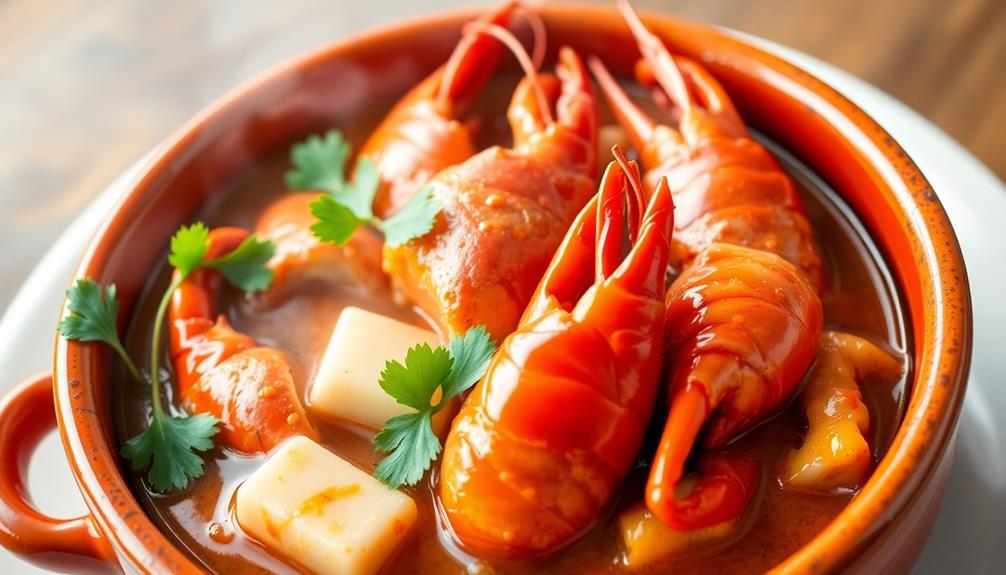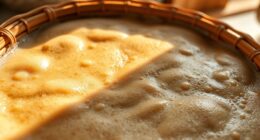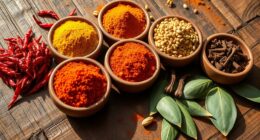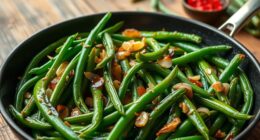Cornbread is a delicious American classic that's been around for centuries. You'll love its golden-brown crust and soft, crumbly texture. It's easy to make with simple ingredients like cornmeal, flour, milk, and eggs. Bake it in a cast-iron skillet for that perfect crispy edge. Cornbread goes great with chili, barbecue, or just on its own with a pat of butter. It's a staple in Southern cooking and comfort food across the country. Whether you like it sweet or savory, there's a cornbread recipe out there for everyone. Get ready to explore the rich history and tasty variations of this beloved dish.
Key Takeaways
- Cornbread is a traditional American bread made primarily from cornmeal, with roots in Native American cuisine.
- It's a staple in Southern cooking, often served as a side dish with chili, barbecue, or other savory meals.
- Basic ingredients include cornmeal, flour, buttermilk, eggs, baking powder, and sometimes sugar, depending on regional preferences.
- Cornbread is typically baked in a cast-iron skillet or baking pan at 400-425°F (200-218°C) for 20-25 minutes.
- Variations include adding corn kernels, jalapeños, cheese, or making sweeter versions, showcasing its versatility in American cuisine.
History
Cornbread's roots run deep in American history. You might be surprised to learn that this tasty bread has been around for centuries! Native Americans were the first to create cornbread, using ground corn as their main ingredient. They'd mix it with water and cook it on hot stones or in clay pots.
When European settlers arrived, they quickly adopted this hearty staple. Cornbread became a go-to food for pioneers as they moved westward. It was easy to make and didn't spoil quickly, making it perfect for long journeys.
During the Civil War, cornbread was a lifesaver for both Union and Confederate soldiers. It was cheap, filling, and could be made with limited ingredients.
After the war, cornbread remained popular in the South, where it became a beloved part of soul food cuisine.
Today, you'll find many different types of cornbread across the country. Some are sweet, while others are savory. You might enjoy it with butter, honey, or as a side dish with chili.
No matter how you eat it, cornbread continues to be a cherished part of American food culture.
Recipe
Cornbread is a beloved staple of Southern American cuisine, known for its golden color, slightly sweet flavor, and crumbly texture. This quick bread is versatile, pairing well with chili, barbecue, or simply enjoyed on its own with a pat of butter. It’s also a popular side dish at traditional Southern gatherings, like family reunions and church picnics. In many Southern households, it’s common to serve cornbread alongside fried chicken, collard greens, and other classic dishes. Speaking of Southern cuisine, have you ever wondered how country ham is made?
This recipe yields a moist and flavorful cornbread that can be baked in a cast-iron skillet for a crispy crust or in a regular baking pan for a softer version. The addition of buttermilk gives the bread a tangy flavor and helps create a tender crumb.
- 1 cup yellow cornmeal
- 1 cup all-purpose flour
- 1/4 cup granulated sugar
- 2 teaspoons baking powder
- 1/2 teaspoon baking soda
- 1/2 teaspoon salt
- 1 cup buttermilk
- 1/3 cup vegetable oil
- 2 large eggs
- 1/4 cup melted butter
Preheat the oven to 400°F (200°C). In a large bowl, whisk together the dry ingredients. In another bowl, combine the wet ingredients. Pour the wet mixture into the dry ingredients and stir until just combined. Be careful not to overmix.
Pour the batter into a greased 9-inch cast-iron skillet or baking pan. Bake for 20-25 minutes, or until a toothpick inserted into the center comes out clean.
For the best results, avoid overmixing the batter, as this can lead to tough cornbread. If you don't have buttermilk on hand, you can make a substitute by adding 1 tablespoon of white vinegar or lemon juice to 1 cup of milk and letting it sit for 5 minutes.
For variations, try adding 1/2 cup of corn kernels, diced jalapeños, or shredded cheddar cheese to the batter before baking.
Cooking Steps
Get ready to bake some delicious cornbread!
You'll start by preheating your oven to 425°F and mixing the dry ingredients together.
Next, you'll add the wet ingredients, mix everything well, and pour the batter into a skillet before baking it for 20-25 minutes.
Step 1. Preheat Oven to 425°F
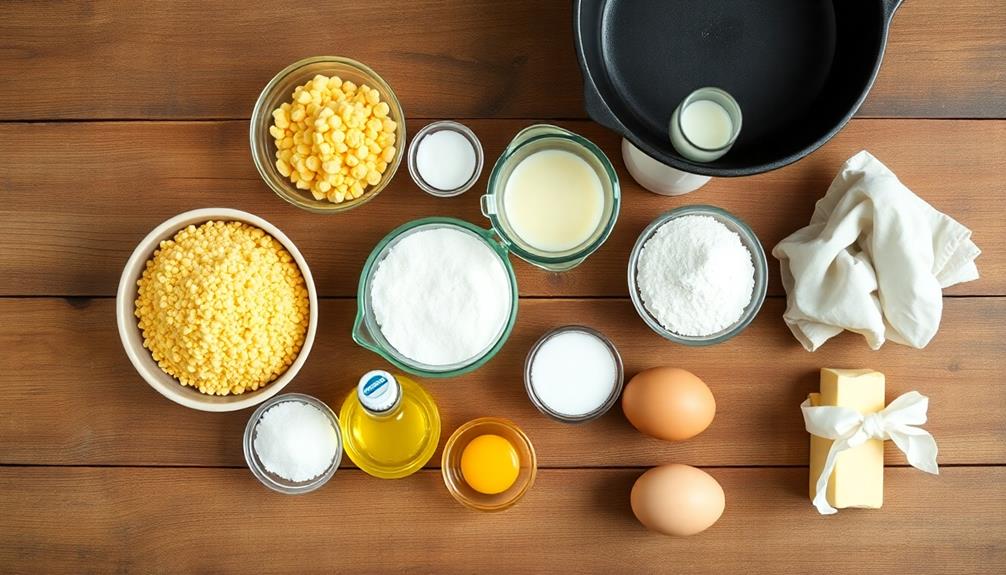
Before diving into the mixing process, turn on your oven and set it to 425°F (218°C). This step is crucial for ensuring your cornbread bakes evenly and develops that perfect golden-brown crust.
While your oven heats up, you'll have time to gather your ingredients and prepare your baking dish.
Preheating is important because it creates the right environment for your cornbread to cook properly. When you put the batter into a hot oven, it starts to rise immediately, giving you a light and fluffy texture.
If the oven's not hot enough, your cornbread might end up dense or unevenly cooked.
Step 2. Mix Dry Ingredients Together
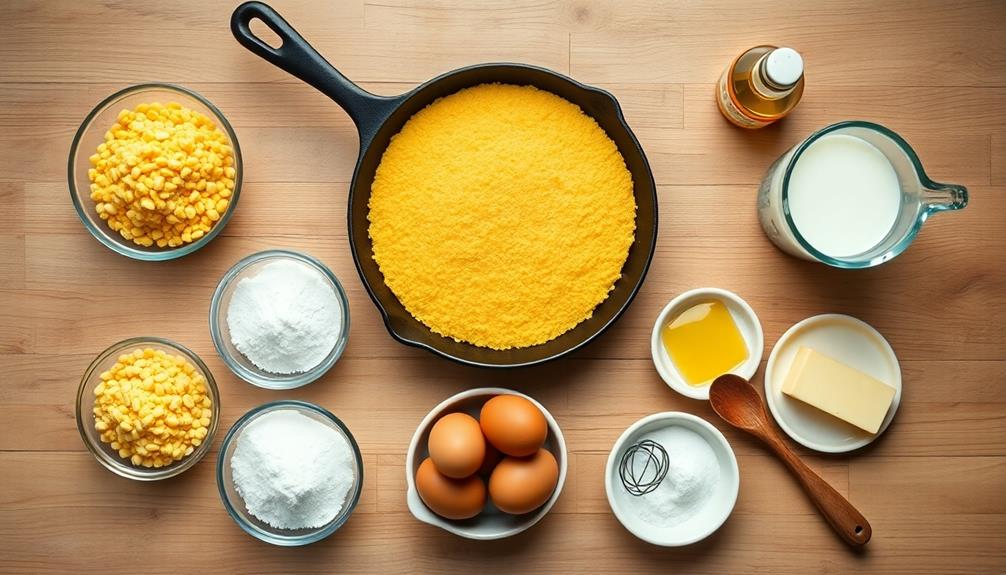
The first step in creating your cornbread batter is to combine the dry ingredients. You'll need a large mixing bowl to get started. Grab your cornmeal, all-purpose flour, sugar, baking powder, and salt. These are the key components that'll give your cornbread its signature taste and texture.
First, measure out the cornmeal. It's the star of the show! Next, add the flour. These two form the base of your cornbread.
Now, it's time for a little sweetness. Sprinkle in the sugar to balance out the savory flavors. Don't forget the baking powder – it's what'll make your cornbread rise and become fluffy. Finally, add a pinch of salt to enhance all the flavors.
Once you've got all your dry ingredients in the bowl, it's time to mix them together. Use a whisk or a fork to blend everything evenly.
Make sure there aren't any lumps or pockets of unmixed ingredients. Stir it well, and you'll have a perfect dry mix ready for the next step in your cornbread adventure!
Step 3. Add Wet Ingredients, Mix

With your dry ingredients perfectly combined, it's time to add the wet components. In a separate bowl, crack two eggs and give them a quick whisk. Now, pour in a cup of milk and add a quarter cup of melted butter. Mix these wet ingredients together until they're well blended.
Create a small well in the center of your dry mix. This is where you'll pour your wet ingredients. Slowly add the wet mixture to the dry, stirring gently as you go. Don't overmix! It's okay if the batter is a little lumpy. You just want to make sure there aren't any big pockets of dry flour.
Use a rubber spatula to fold the ingredients together. This helps prevent overmixing and keeps your cornbread tender. As you mix, you'll see the batter come together. It should be thick but pourable, like pancake batter.
If it seems too dry, you can add a splash more milk. Once everything is just combined, stop mixing. Your cornbread batter is ready for the next step!
Step 4. Pour Batter Into Skillet
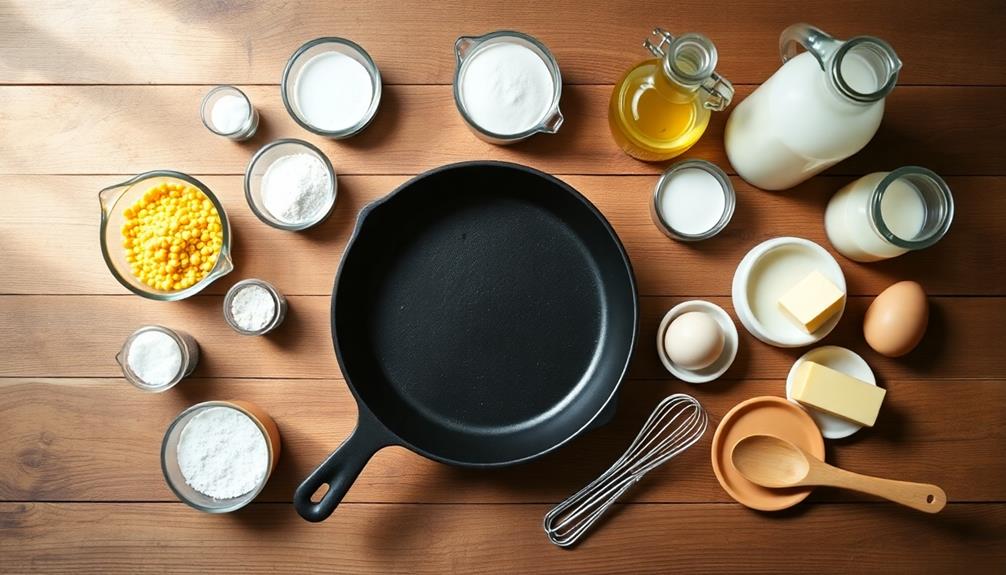
Now that your batter is ready, it's time to prepare your skillet. Grab your trusty cast-iron skillet and place it in the oven while it's preheating. This step is crucial for achieving that perfect, crispy crust on your cornbread.
Once the oven and skillet are hot, carefully remove the skillet using oven mitts. It'll be very hot, so be extra careful! Next, add a tablespoon of butter to the skillet and swirl it around. Watch as it sizzles and melts, coating the bottom of the pan.
Now comes the exciting part! Pour your cornbread batter into the hot skillet. You'll hear a satisfying sizzle as the batter hits the hot surface. Use a spatula to spread the batter evenly, making sure it reaches all the edges.
Don't worry if you see the edges starting to cook right away – that's exactly what you want! This quick cooking of the edges will give your cornbread that delicious, crispy crust.
Once you've poured and spread the batter, it's time to pop the skillet back into the oven and let the magic happen!
Step 5. Bake for 20-25 Minutes

Anticipation builds as you slide your skillet filled with cornbread batter into the preheated oven. Now, it's time to let the magic happen! Set your timer for 20 minutes and resist the urge to peek. The aroma of baking cornbread will soon fill your kitchen, making your mouth water.
While you wait, keep an eye on the clock. At the 20-minute mark, carefully open the oven door and check your cornbread. It should be golden brown on top and slightly pulling away from the sides of the skillet. If it's not quite done, give it a few more minutes. You'll know it's ready when a toothpick inserted into the center comes out clean.
Once your cornbread is perfectly baked, remove the skillet from the oven using oven mitts. Be careful, as the skillet will be very hot!
Let it cool for a few minutes before serving. This cooling time allows the cornbread to set, making it easier to slice. Your patience will be rewarded with a delicious, warm treat that's crispy on the outside and soft on the inside.
Final Thoughts
Cornbread's enduring popularity speaks volumes about its versatility and appeal. It's a dish that's been loved for generations, and it's easy to see why.
Whether you're enjoying it with a bowl of chili or as a side to your favorite barbecue, cornbread always hits the spot.
You've now learned how to make this classic treat, and it's time to put your skills to the test. Don't be afraid to experiment with different add-ins like cheese, jalapeños, or even corn kernels. The possibilities are endless!
Remember, practice makes perfect, so keep trying until you find your perfect recipe.
Cornbread isn't just delicious; it's also a great way to connect with family and friends. Share your homemade cornbread at potlucks, picnics, or family dinners. It's sure to be a hit!
As you become more comfortable with the recipe, you might even want to teach others how to make it. Passing on this culinary tradition is a wonderful way to keep the love of cornbread alive for future generations to enjoy.
Frequently Asked Questions
Can Cornbread Be Made Gluten-Free?
Yes, you can make gluten-free cornbread. You'll need to use gluten-free cornmeal and substitute regular flour with alternatives like almond flour, rice flour, or a gluten-free all-purpose blend. It's easy to adapt traditional recipes for dietary needs.
How Long Does Homemade Cornbread Stay Fresh?
You'll find your homemade creation stays fresh for about 2-3 days at room temperature. If you refrigerate it, you'll get up to a week. For longer storage, you can freeze it for up to 3 months.
What's the Difference Between Northern and Southern Cornbread?
You'll notice Northern cornbread is sweeter and cake-like, often using sugar and flour. Southern cornbread is savory, made with little or no sugar, and uses mostly cornmeal. It's typically baked in a cast-iron skillet for a crispy crust.
Can Cornbread Batter Be Prepared in Advance?
You can prepare cornbread batter in advance, but it's best to mix dry and wet ingredients separately. Store them in the fridge for up to 24 hours. When you're ready to bake, combine them quickly and pop it in the oven.
Is Cornbread Healthier Than Regular Bread?
You'll find cornbread isn't necessarily healthier than regular bread. It's typically higher in calories and fat, but it can be richer in fiber and nutrients. Your choice depends on your dietary needs and preparation method.

